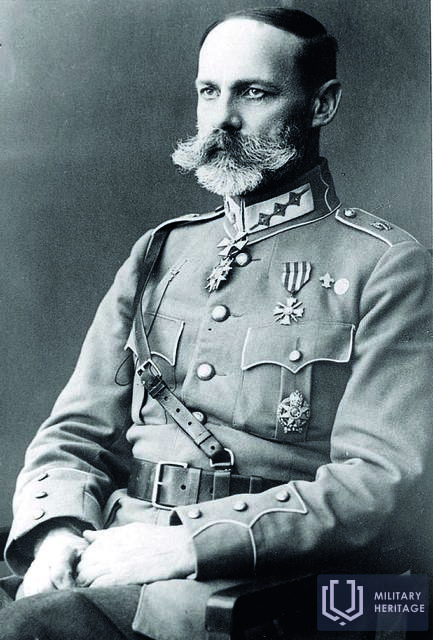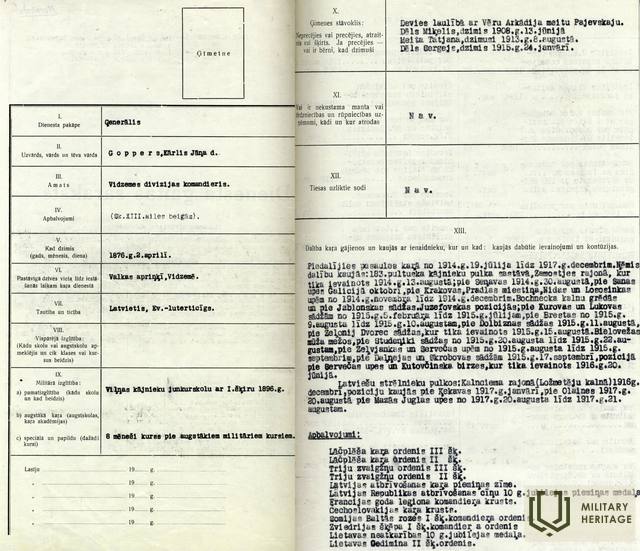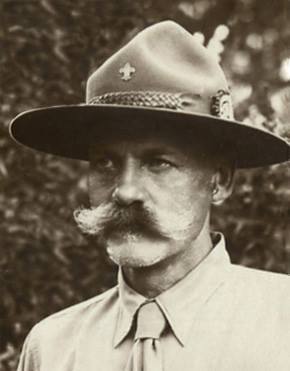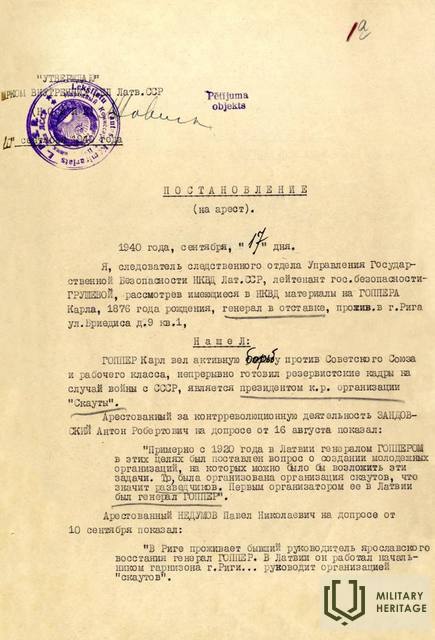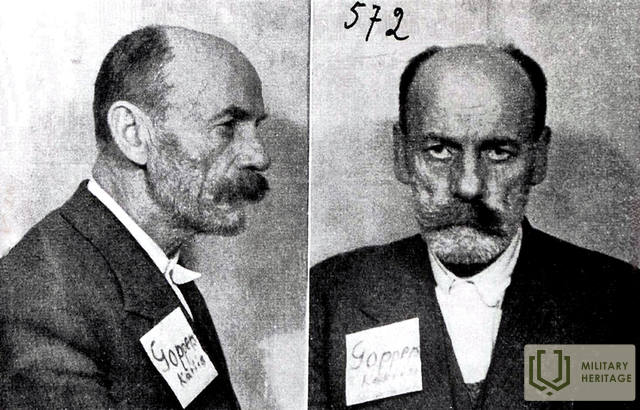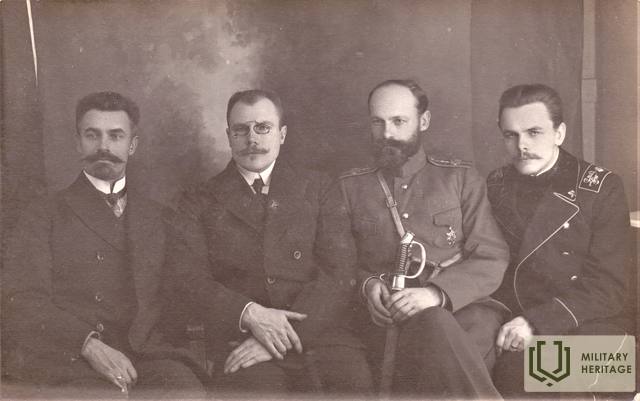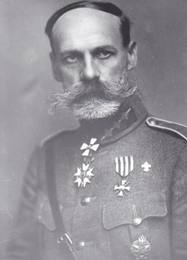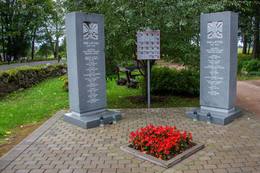About General Karlis Goppers
General K. Goppers (1876-1941) was an outstanding soldier and an outstanding person. He distinguished himself as a successful commander who took command of battalions and regiments, heroically leading his riflemen in battles for the freedom of Latvia during the First World War (1914-1919). He participated in the battles at Tīreļpurva, Ložmetējkalns, and in the defense of Riga.
Born on April 2, 1876 in "Maskatos" of Plāņi parish.
He studied at the Trikāta parish school. After graduating, he prepared for the barbarian exam there, which he passed, and continued his studies at the Pskov Cadet Corps.
In 1893 he began his service in the Tsarist army. During World War I he was wounded and promoted several times. In August 1916, after recovering from his wound, he was appointed, at his own request, as a lieutenant colonel, commander of the Latvian Riflemen Reserve Battalion, and in December - commander of the 7th Bauska Latvian Riflemen Regiment. From 1917, commander of the 1st Latvian Riflemen Brigade. From 1917 to June 1920, he traveled throughout Russia fighting against the Bolsheviks. In August 1920, he was promoted to general, counting from August 13, 1917, as the approval of the promotion was delayed due to the October Revolution. After returning to his homeland, he was the head of the Latvian Scouts Central Organization, the chairman of the Ministry of Security, respectively, the War Council, the head of the Old Latvian Riflemen Association, and a member of the Colonel Briežs Foundation. During his life, he was awarded many Latvian, Russian, and foreign military orders.
On September 30, 1940, K. Goppers was arrested in Riga. On March 25, 1941, he was executed in Riga Central Prison and buried in a mass grave in Ulbrokas Forest. In May 1944, K. Goppers was reburied in Riga's Brothers' Cemetery, and his heart was reburied in Trikāta Cemetery on May 7, 1944.
On February 11, 1992, Kārlis Goppers was rehabilitated in accordance with the Law of the Republic of Latvia of August 3, 1990 "On the Rehabilitation of the Unlawfully Repressed".
Awarded the 3rd Class Lāčplēsis War Order for being the first to break through the German fortification line with his regiment on the night of December 23, 1916, while in the attacking column of the 2nd Latvian Rifle Brigade, and breaking through the German fortification line in fierce battles deep behind enemy lines, where he also took command of the 8th Valmiera Latvian Rifle Regiment and held out for 2 days until reinforcements arrived on the night of December 25, then led his units in an attack in the direction of Kalnciems, causing panic in the German ranks near Ložmetējkalns, largely contributing to its capture and the acquisition of trophies, which were so much needed by the riflemen to replenish their poor arsenal.
The 2nd Class Lāčplēsis War Order was awarded to him for the fact that on August 21, 1917, in the Jugla positions, when the 1st Latvian Rifle Brigade alone, without artillery support, had to withstand extremely fierce attacks, he repelled several frontal attacks, skillfully maneuvered with reserves and, by changing positions from Mazā Jugla to Liela Jugla, prevented the siege and facilitated our holding out until receiving the order to leave.
General Karl Goppers' service ranks :
In 1893 – he enlisted as a second-class private (high school graduate) and entered military service in the Kaunas Fortress Infantry Battalion.
In 1894 – Vilnius Infantry Junkers School. Second Lieutenant (first officer rank).
In 1896, he began his service in the 97th Vidzeme Infantry Regiment in Daugavpils, in the 190th Infantry Regiment stationed in Warsaw (he studied philosophy and natural sciences in parallel with his service).
In 1900 – promoted to lieutenant (the youngest officer rank).
In 1904 – promoted to staff captain (senior officer rank).
1905 – serving in the 183rd Regiment in Pultusk and Kostroma.
In 1908 – promoted to captain (in the Russian Imperial Army, a hierarchical rank between staff captain and lieutenant colonel).
In 1912 – appointed company commander.
In 1914, he fought on the Western Front in Galicia, Austria-Hungary (present-day Ukraine), and was appointed battalion commander.
Wounded three times from 1914 to 1916. After the third injury, evacuated to a hospital in Moscow.
In 1915 – promoted to lieutenant colonel.
In 1916 – promoted to colonel and appointed commander of the Latvian Riflemen Reserve Battalion, sent to Valmiermuiža, at the end of the year appointed commander of the 7th Bauska Latvian Riflemen Battalion.
In 1917 – appointed commander of the 1st Latvian Rifle Brigade, and for his combat merits in the defense of Riga on August 19–21, Radko Dmitrijevs recommends him for promotion to major general. Approved!
Going through the Russian Civil War with the rank of colonel!
During his military career, K. Goppers received the Latvian Lāčplēsis War Order of the 2nd and 3rd class, the Order of the Three Stars of the 2nd and 3rd class, the Scout Order of the White Lily, as well as several high awards from Russia, France, Sweden, Finland, Lithuania, Serbia, and Czechoslovakia.
Awards and honors :
Order of St. Stanislav of Russia, 3rd class
Order of St. Anne of Russia, 3rd class
The Russian Sword of St. George
Order of St. Stanislav of Russia, 2nd class
Order of St. Anne of Russia, 2nd Class
Order of St. George, 4th class, Russia
Order of St. Vladimir, 4th class, Russia
Order of St. Vladimir, 3rd class, Russia
Order of St. George, 3rd class, Russia
Serbian Kađorđević Stars, III Class
Lāčplēsis War Order, 3rd Class
Commander's Cross of the French Legion of Honor
Czechoslovak War Cross
Latvian Liberation War Memorial
Commander of the Order of the White Rose of Finland, 1st Class
Lāčplēsis War Order, 2nd Class
Order of the Three Stars, 3rd Class
Commander's Cross, 1st Class, of the Swedish Order of the Spear
Commemorative Medal of the 10th Anniversary of Lithuanian Independence
Order of the Three Stars, 2nd Class
Commemorative medal of the 10th anniversary of the liberation struggle of the Republic of Latvia
Lithuanian Order of Gediminas, 2nd Class
Latvian Defence Society Bronze Medal
Latvian Scouts Order of the Grey Wolf
Latvian Scouts Order of the White Lily
Latvian Scouts' Badge of Appreciation "Swastika"
Latvian Scouts "Forest Sign"
Books, publications :
''Four Collapses'', 1920
''Fundamentals of Military Education'', 1922
''The Godfather Oscar'', 1923
''Be vigilant'', 1924
''Latvian Rifle Regiment Christmas'' 1916, 1924
Between two revolutions
Memories of the ''Riflemen'' era, 1931.
In 1924–1925 and 1934–1940 — editor of the magazine "Latvian Riflemen".
After World War II, on April 20, 1947, exiled Latvian scouts in refugee camps in Germany established the "Latvian Scout President General Kārlis Goppers Foundation" in Ansbach.
https://www.historia.lv/personas/goppers-karlis
http://skauti.lv/par-mums/vesture/karlis-goppers/
http://www.karamuzejs.lv/lv/Izstades/generali/generalis_GoppersKarlis.aspx
https://www.facebook.com/media/set/?set=a.616149468468565.1073741850.568253149924864&type=3
https://enciklopedija.lv/skirklis/101930-K%C4%81rlis-Goppers
''General Goppers in the memories of war and contemporaries'', Zelta Abele publishing house, 1951. Sweden
Related topics
Related objects
General Karls Goppers Memorial Room in his birthplace "Maskati"
Located in Plāņi parish on the banks of the Vija River.
The memorial room of General Kārlis Goppers in his birthplace "Maskati" can be visited.
The “Maskatu” farm was run by the general’s brother Augusts Goppers, because the talented war leader was busy with major events and world wars. In 1920, the general returned to Latvia, to his native home. But many responsible duties connected him to Riga. Augusts continued to manage “Maskatu”. In 1940, General Goppers was arrested and shot in the Cheka cellars on March 25, 1941. In 1944, the Gopper family fled to Courland with three horse-drawn carriages. The war divided the family, and Aleksandrs Goppers’ daughters – Biruta, Elza and Anna – remained in Latvia. They were no longer allowed to return to “Maskatu”. The houses were large and carefully maintained. Three or four families of newcomers were accommodated there in separate rooms. A horse farm was set up in the large barn. Due to mutual quarrels, a fire broke out in 1980. The barn and the large shed burned down. Fortunately, the fire did not spread to the house, the flames were repelled by large trees planted by our ancestors.
In 1991, after the miraculous Awakening, the Latvian state was reborn for the second time. In 1992, the family of General Goppers' brother August regained “Maskatus” as a sacred place of their ancestors. For ten years, everyone worked hard to save the houses from destruction, to restore and rebuild the destroyed buildings, to make the entire “Maskatus” farm beautiful. The houses have been restored to their ancient appearance, and a memorial room for General Kārlis Goppers has also been set up. The memorial room can be visited by calling in advance and making an appointment at +371 29396870, +371 29254285.
Memorial sites of generals and knights of the Lāčplēsis Military Order in Trikāta parish
The memorial stele is located next to the Trikāta cemetery chapel.
The Trikāta cemetery preserves the memory of three outstanding Latvian generals - Roberts Dambītis, Kārlis Goppers and Jānis Balodis. The teacher of all these generals, Jēkabs Mūrnieks, is also buried in the Trikāta cemetery, for whom a monument made of travertine, modeled after Kārlis Zāle, was erected at the burial site in 1928.
The generals and knights of the Lāčplēsis Military Order are commemorated every year with torchlight processions to the Trikāta cemetery, where there are two memorial steles, in which a total of 17 names of knights of the Lāčplēsis Military Order associated with the Trikāta parish are engraved.
The stele was unveiled on November 11, 2018.
Video about the Lāčplēsis War Order and a set of orders that belonged to General Jānis Balodis.
Brothers' Cemetery in Riga
Riga Brothers’ Cemetery is located in the northern district of Riga. The cemetery extends over an area of 9 ha and is the most outstanding and significant memorial ensemble in Latvia dedicated to the fallen Latvian soldiers. About 3,000 soldiers are buried here. The Brothers’ Cemetery was created during World War I after the first three Latvian Riflemen, who fell in Tīreļpurvs in the battle against the German Army, were buried here. Later Latvian soldiers who had died in other battles and wars would also be buried in the Brothers’ Cemetery. The memorial is based on the design of the sculptor Kārlis Zāle, and is the first memorial ensemble in Europe with such landscape, architecture and sculptural value. It uses elements typical to the Latvian landscape, traditional farmsteads, Latvian folklore and history that praise the characteristics of soldiers and tell the story of the way of the soldier. The memorial was unveiled in 1936 and it has three parts: ‘The Road of Though’ which is a 250 m long alley, ‘Terrace of Heroes’ with the Altar of the Sacred Flame and ensemble the Sacred Oak Grove, and the burial ground with the Latvian wall and a memorial of a mother with her fallen sons.




